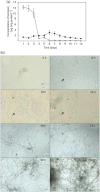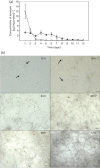Development of monoclonal antibodies to recombinant terrelysin and characterization of expression in Aspergillus terreus
- PMID: 22160315
- PMCID: PMC3348537
- DOI: 10.1099/jmm.0.039511-0
Development of monoclonal antibodies to recombinant terrelysin and characterization of expression in Aspergillus terreus
Abstract
Aspergillus terreus is an emerging pathogen that mostly affects immunocompromised patients, causing infections that are often difficult to manage therapeutically. Current diagnostic strategies are limited to the detection of fungal growth using radiological methods or biopsy, which often does not enable species-specific identification. There is thus a critical need for diagnostic techniques to enable early and specific identification of the causative agent. In this study, we describe monoclonal antibodies (mAbs) developed to a previously described recombinant form of the haemolysin terrelysin. Sixteen hybridomas of various IgG isotypes were generated to the recombinant protein, of which seven demonstrated reactivity to the native protein in hyphal extracts. Cross-reactivity analysis using hyphal extracts from 29 fungal species, including 12 Aspergillus species and five strains of A. terreus, showed that three mAbs (13G10, 15B5 and 10G4) were A. terreus-specific. Epitope analysis demonstrated mAbs 13G10 and 10G4 recognize the same epitope, PSNEFE, while mAb 15B5 recognizes the epitope LYEGQFHS. Time-course studies showed that terrelysin expression was highest during early hyphal growth and dramatically decreased after mycelial expansion. Immunolocalization studies demonstrated that terrelysin was not only localized within the cytoplasm of hyphae but appeared to be more abundant at the hyphal tip. These findings were confirmed in cultures grown at room temperature as well as at 37 °C. Additionally, terrelysin was detected in the supernatant of A. terreus cultures. These observations suggest that terrelysin may be a candidate biomarker for A. terreus infection.
Figures






References
-
- Andrew S. M., Titus J. A. (1997). Purification and fragmentation of antibodies. In Current Protocols in Immunology, pp. 2.7.1–2.7.12 Somerset, NJ: Wiley
-
- Balajee S. A., Baddley J. W., Peterson S. W., Nickle D., Varga J., Boey A., Lass-Flörl C., Frisvad J. C., Samson R. A., ISHAM Working Group on A. terreus (2009b). Aspergillus alabamensis, a new clinically relevant species in the section Terrei. Eukaryot Cell 8, 713–722 10.1128/EC.00272-08 - DOI - PMC - PubMed
Publication types
MeSH terms
Substances
Grants and funding
LinkOut - more resources
Full Text Sources
Molecular Biology Databases

